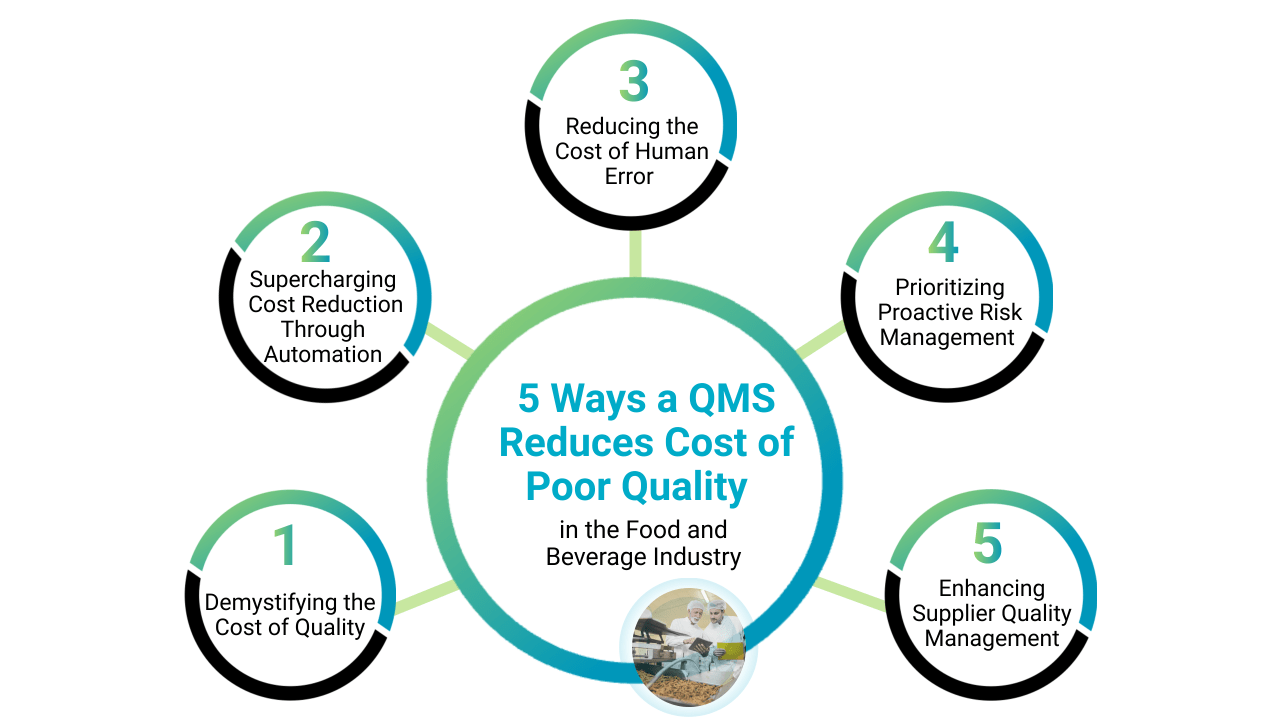The cost of poor quality (COPQ) is an important consideration for any food and beverage company looking to operate safely and efficiently. Still, care must be taken to ensure the cost of good quality isn’t also sacrificed. Often, cutting corners results in expensive recalls and hurts a company’s reputation. However, actively taking steps to prevent quality issues can lower the overall cost of quality, all while maintaining the final product’s quality.
The cost of poor quality can spiral out of control when no quality management system (QMS) is in place. Leaving issues unresolved and changes unmanaged lets errors fester, driving up the costs associated with low-quality output.
Between 2021 and 2023, an estimated 70% of all food-related recalls resulted from “loss of control during the packaging and labeling processes.” These recalls were attributed to multiple types of operational errors. Unfortunately, Packaging and labeling mistakes are some of the most common issues businesses face. However, the good news is that these mistakes are also some of the easiest to prevent with the right systems and tools in place.
For organizations striving to balance cost-effectiveness and quality, the role of a QMS becomes indispensable.

Here are five ways a QMS can help food and beverage brands prioritize quality while reducing the overall CoPQ:
1. Demystifying the Cost of Quality
Figuring out the cost of quality is not as complicated as it might seem. Maintaining good quality and preventing defects comes at a cost, known as the cost of quality (CoQ). This cost includes proactive measures like quality control and reactive expenses incurred when problems arise. There’s a simple formula for this:
CoQ = Cost of Good Quality (CoGQ) + Cost of Poor Quality (CoPQ)
Investment in good quality is vital in keeping costs low. These expenses help prevent quality issues and cultivate a culture of good quality within an organization. In the food and beverage sector, prioritizing investments in quality is crucial. Lapses in quality can have serious consequences, from compromised food safety to costly recalls.
A QMS helps organizations better understand these quality costs, including:
Prevention costs
Prevention costs are expenses intended to keep failures at a minimum. This category of costs includes quality planning, employee training and education, process controls, supplier quality assurance, and costs related to implementing quality management technology.
Appraisal costs
These are costs incurred when assessing and maintaining quality levels. These costs include materials inspections, equipment calibration, supplier assessments, and quality audits.
The costs of poor quality, on the other hand, include:
Internal failures
Internal failures are errors and other problems before the product reaches the customer. A common internal failure for food and beverage companies is waste caused by defects, spoilage, or inefficient processes. For example, say a batch of products fails to meet quality standards and must be discarded or reprocessed. In this case, that represents an internal failure.
Internal failures often lead to increased production costs, production delays, and an increase in waste material.
External failures
If something goes wrong after a product has already reached the customer, that would be an external failure. Common external failures include customer complaints, warranty claims, shipping damage, product returns, recalls, and public health alerts. For example, if a customer becomes ill due to a contaminated food product and reports it, this qualifies as an external failure.
External failures can have severe consequences, including costly recalls, legal issues, and reputational damage.
2. Supercharging Your Cost Reduction Through Automation
Although it is a quality-related expense, implementing a QMS can drive down your overall CoQ in multiple ways, including:
Swift Problem Resolution
A key cost reduction element is addressing issues before they can evolve into bigger problems. A QMS does this through:
- Automated Corrective and Preventive Action (CAPA) processes: By automating the process of reviewing an issue, identifying its root cause, and taking immediate action, you can quickly detect problems. This proactive approach helps prevent them from snowballing into major issues.
- Intelligent issue prioritization using risk-based filtering: Risk-based filtering allows businesses to prioritize the most important issues. This means far fewer errors slip through the cracks. As a result, delays are less likely to occur.
- Total visibility across operations to pinpoint problems swiftly: With complete visibility across operations, it’s easier to identify the source of an issue. This makes problem-solving a systematic process rather than a frantic, disorganized one.
Seamless Change Management
Change is constant in any organization, and a QMS helps manage that change and navigate it easily by:
- Analyzing the costs and risks associated with different options: A QMS can calculate potential costs and risk levels, allowing businesses to make the best decision for them.
- Simplifying change management with integrated tools: Tools that create visibility and collaboration make shifts more straightforward and streamline the business’s immediate future.
- Linking processes like employee training and document control: Having vital data hosted within a QMS ensures a source of truth and removes confusion. Document control, for example, guarantees information is kept safely in one secure but accessible location.
Minimizing Operational Errors
A QMS reduces the likelihood of operational errors by providing accurate, up-to-date data. It also offers visibility into all aspects of the production process. QMS platforms also facilitate timely employee training and streamline the CAPA process. Many quality and food safety issues can be traced back to operational errors. Therefore, a QMS is indispensable for dealing with these problems before they escalate.
3. Reducing the Cost of Human Error
Although your team members are indispensable to your company’s success, human error plays a major role in CoPQ. Mistakes can still happen even with the best, most sophisticated production systems in place. But by equipping employees with an integrated QMS, businesses can limit the possibility of human error in several ways:
- Enhancing employee training programs and tracking proficiency: With a QMS, employees will receive the appropriate training for their location, department, and role. Plus, assessing their proficiency test results via the QMS is easy.
- Providing real-time data and automated alerts to prevent errors: A QMS updates data automatically across all locations simultaneously, meaning it’s always accurate no matter who’s accessing it. This helps prevent problems before they have the chance to happen.
- Streamlining workflows to standardize processes and ensure consistency: A QMS allows businesses to automate, customize, and standardize workflows. This makes it easier to create a solution tailored to suit their needs. Additionally, it ensures standardization across business locations and functions.
4. Prioritizing Proactive Risk Management
Organizations without a strong quality management program often operate in a reactive mode. Instead of proactive prevention, they focus on scrambling to solve problems after they arise. Choosing this approach is risky for food and beverage companies. It significantly raises the chances of product recalls, which can severely damage their reputation.
Making risk management a priority requires a proactive approach. Reducing CoPQ requires effective risk management. Here are some ways a QMS helps food and beverage businesses become more proactive:
- Risk tools within various processes, including audit management: Having thoughtfully placed tools to monitor risk helps weed out potential problems before they can occur. Audit management is critical, as audits create enormous amounts of data and long lists of action items.
- Clear identification of high-risk areas to prioritize follow-ups: A QMS allows quality managers to identify the highest-risk gaps to fill first. That means business hours are spent most effectively, thus dramatically reducing potential issues.
- Industry-specific compliance monitoring: Companies can use QMS platforms to ensure compliance with the most up-to-date industry standards and regulatory requirements. This includes FSMA, GMP, SQF, HACCP, and other guidelines.
- Centralized reporting based on risk for informed decision-making: Data-driven, risk-based reporting allows businesses to make more informed, strategic decisions while reducing CoQ.
5. Enhancing Supplier Quality Management
Unfortunately, even when a supplier is at fault for poor quality, it still reflects poorly on your organization. This can leave customers with a negative impression of your brand. For this reason, supplier quality management is paramount.
An integrated QMS simplifies supplier management and provides performance benchmarking tools. This system also facilitates increased and improved communication, further strengthening supplier relationships. When high costs are driven by poor supplier quality, a QMS can help by offering:
- Detailed supplier ratings to identify top-performing suppliers: This allows you to identify your top-performing suppliers, specifically influencing those that contribute the most to quality costs.
- Secure portals for efficient communication and problem resolution: Approved users can access open corrective actions from anywhere using these portals, leading to faster problem resolution.
- Reporting tools for data-driven supplier negotiations: Reporting tools enable quick access to data, allowing businesses to produce evidence promptly during supplier negotiations.
One national fast-food chain uses a QMS to centralize and automate its vendor approval system. Features like a user-friendly form wizard and document tracker increase visibility and prevent requests from languishing in email inboxes. These features have allowed the company to speed up the vendor approval process. They have also helped bring new products to market faster without cutting corners on vendor quality.
Your Path to Cost-Effective Quality
Improving quality and bringing down costs starts by looking within the organization. A quality management system provides quality specialists and business leaders the tools to accomplish this quickly and efficiently. With a QMS that syncs seamlessly across all business areas, it’s easy to get a comprehensive view of current quality efforts. It also allows for a better understanding of areas that could be optimized.
Thriving in the food and beverage industry involves relentlessly pursuing improvements in product quality. However, achieving this excellence shouldn’t come at the expense of efficiency. Minimizing the cost of quality is equally crucial for long-term success. This comes down to preventing costs relating to waste, recalls, returns, and damage to brand reputation.
One key way to do this is using a QMS to identify potential issues early in manufacturing. This strategy reduces the likelihood of defects further down the line, where they are more difficult (and costly) to correct.



![A Formula for Food Safety: HARPC = CCP + PRP + OPRP [Podcast] thumbnail](/app/uploads/2020/07/etq-food-pyramid.jpg)